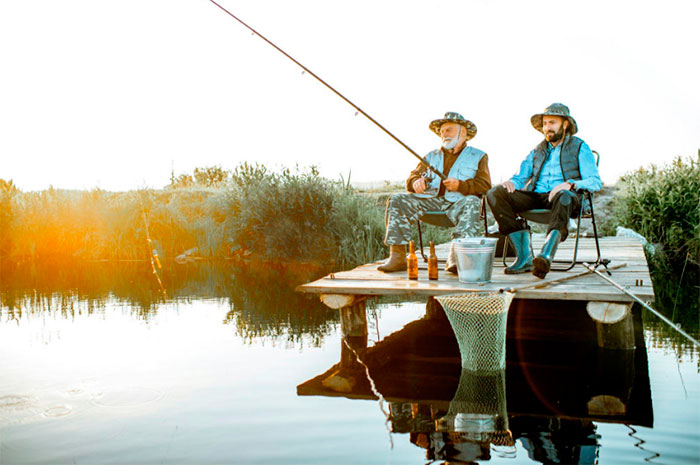Fishing in the United States offers an incredible range of opportunities. Whether it’s casting for bass in a southern lake, trolling for salmon in a northern river, or dropping a line through the ice in winter, anglers can find a destination to match their passion. From freshwater lakes and rivers to saltwater coasts and estuaries, the variety of species and settings is unmatched. As pointed out by Jett Harris Arkansas, planning the right trip means understanding not only where to go, but also when and how to fish each location effectively.

In many areas, local guides and outfitters make it easier for newcomers to learn the waters and improve their chances of success. With responsible practices and a little preparation, a fishing trip in the U.S. can provide not just a chance at a trophy catch but also a deeper appreciation for the natural beauty of each region.
Lakes and Reservoirs Worth Exploring
Lakes across the country offer some of the most rewarding freshwater fishing experiences. Lake of the Woods in Minnesota is a northern gem, famous for its abundance of walleye and northern pike, especially during early summer and ice fishing season. Its remote beauty and extensive shorelines make it a favorite among anglers who enjoy boating and ice fishing.
Moving south, Alabama’s Lake Guntersville remains a hotspot for largemouth bass, drawing competitive anglers and casual fishers alike. The lake’s structure—filled with grass beds, ledges, and coves—makes it ideal for varied techniques, from topwater lures to deep crankbaits. Seasonal tournaments often bring in some of the country’s best bass anglers, adding to the lake’s reputation.
Lake Erie, stretching across Ohio, Pennsylvania, and New York, continues to earn its title as the walleye capital of the U.S. The western basin is particularly productive in spring when the fish move closer to shore, while smallmouth bass thrive along rocky drop-offs and reefs throughout the summer. Many charter services operate out of nearby towns, making it easy to access prime fishing spots even for visitors unfamiliar with the lake.
Coastal and Saltwater Hotspots
Anglers seeking saltwater action will find plenty to love along the U.S. coastline. The Florida Keys, with their turquoise waters and shallow flats, offer thrilling opportunities to catch tarpon, bonefish, and permit. Local charter captains know the tides and migration patterns well, which helps maximize success on the water. Fly fishing on the flats is especially popular, requiring skill and patience that are rewarded with memorable catches.
The Outer Banks of North Carolina combine scenic beaches with serious surfcasting potential. Red drum patrol the shallows, particularly in the fall when conditions align. Offshore, anglers chase tuna and billfish during the warmer months, often departing from Oregon Inlet or Hatteras. The area is also known for its strong fishing community and numerous bait shops that help visitors gear up for a day on the water.
Chesapeake Bay, the largest estuary in the U.S., supports a thriving striped bass population. Known locally as rockfish, these gamefish are a regional favorite. The bay also supports a mix of other species like bluefish and croaker, making it ideal for mixed-bag outings.
Top Rivers for Fly and Sport Fishing
The Bighorn River in Montana stands out as a fly fishing paradise, especially for those targeting rainbow and brown trout. Its clear waters and steady hatches make it ideal for fly action throughout much of the year. Access is plentiful, with several prime stretches flowing through public lands. Local fly shops often provide hatch charts and updated conditions to guide visiting anglers.
In the Pacific Northwest, the Columbia River offers a different kind of challenge. With runs of salmon, steelhead, and even sturgeon, it’s one of the most diverse river systems in the country. Many anglers drift fish or troll near the Bonneville Dam, where fish congregate during their upriver migrations. The river’s vastness allows for both bank and boat access, accommodating a wide range of fishing styles.
Alaska’s Kenai River is legendary, not just for its size but also for the trophy king salmon it produces. During peak season, the river draws anglers from around the world. Beyond salmon, it also supports large populations of sockeye and rainbow trout, making it a year-round destination for serious sport fishers.
Cold-Weather Destinations
Winter anglers are drawn to Devils Lake in North Dakota, where thick ice and abundant perch and walleye create an ideal setting for cold-weather fishing. The frozen expanse offers a unique experience, with heated ice shacks, snowmobiles, and sonar playing vital roles in a successful outing. Local outfitters often provide rentals and guide services, making it accessible even for those new to ice fishing.
The Kenai River again earns a mention due to its versatility. While summer sees salmon runs dominate, winter offers a quieter angling atmosphere. Days are shorter, but the solitude and snow-covered surroundings create a peaceful setting unlike any other.
Planning a Fishing Trip: What to Know
Before heading out, it’s important to research local fishing regulations, as seasons and size limits can vary widely between states and even individual bodies of water. Permits are often required, and staying informed helps avoid fines and supports conservation efforts. Some regions also have bait restrictions or catch limits that are strictly enforced, particularly during spawning periods.
Equally important is understanding the seasonal behavior of target species. Some fish spawn in spring, others in fall, and knowing these patterns can make the difference between a quiet day and a full cooler. Planning around migrations, water temperature, and regional weather helps anglers get the most from their trip.
Lastly, responsible fishing practices ensure these destinations remain healthy and productive. Catch and release, proper handling, and respecting habitat go a long way in preserving the experience for future generations. Whether it’s a quick weekend getaway or a bucket-list adventure, a well-planned fishing trip leaves lasting memories. The right preparation can turn even a modest outing into an unforgettable experience.
